Newborn Screening Needs to Keep Pace with Innovation
Before the ACHDNC was dissolved, only 9 core conditions had been added to the RUSP since the RUSP was initially implemented in 2010 and the ACHDNC only had the budget and capacity to review two conditions each year to determine if they should be added to the RUSP.
Since the dissolution of the ACHDNC in April 2025, there remains a wave of innovative therapies in development where NBS will be vital to diagnosis and early intervention.
Because NBS is a vital and proven public health program that saves lives, the NBS system needs to be modernized. To this end, at a minimum we need to:
- Reinstate a restructured ACHDNC comprised of a broader swath of rare disease stakeholders ─ including patients and caregivers ─ that can review conditions for addition to the RUSP
- Ensure that the reinstated, restructured ACHDNC receives sufficient funding to review as many conditions as possible each year
- Reauthorize the elements of the Newborn Screening Saves Lives Reauthorization Act that allow states to improve and expand their NBS programs, support parent and provider education, ensure laboratory quality and facilitate adding conditions to the RUSP
- Ensure adequate funds are provided to states to implement screening of all RUSP conditions
- Increase understanding of the benefits of NBS and current challenges the system faces
Encourage States to Add Conditions to Their State Screening Panel More Quickly
Once a condition is added to the RUSP, the time it takes for each state to include these new conditions on their panels varies widely. In some cases, it has taken 10 years for all 50 states to screen for conditions on the RUSP.
We support states’ efforts to screen for all conditions included on the RUSP and to reduce the time it takes for a state to add a condition to its screening panel once it has been included on the RUSP. In the absence of the ACHDNC condition review and recommendation process, we also encourage states to maintain a list of conditions that have approved treatments so that, whether or not a given condition is added to the RUSP, states can review the condition and add it to their state screening panels as appropriate.
States can work toward this goal by incorporating the following ideal elements of an NBS program:
- Begin screening for each condition on the RUSP within a defined period of time
- Maintain a list of conditions that have approved treatments so that, whether or not a given condition is added to the RUSP, states can review the condition and add it to their state screening panels as appropriate
- Provide the state Public Health Lab and/or Department of Health with the authority to add conditions to the state screening panel in its discretion
- Provide the state Public Health Lab and/or Department of Health with the authority to increase the screening fees as needed to cover all costs associated with the NBS program with periodic legislative oversight
- Provide that the screening fees collected cannot be repurposed to fund other state initiatives

